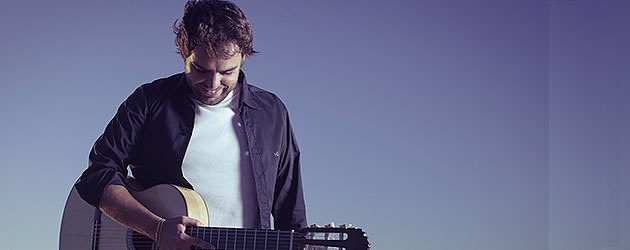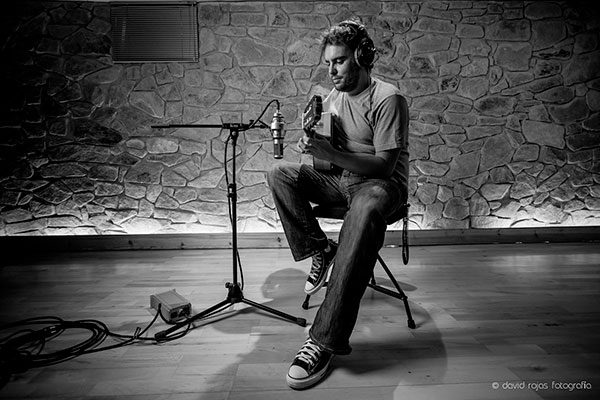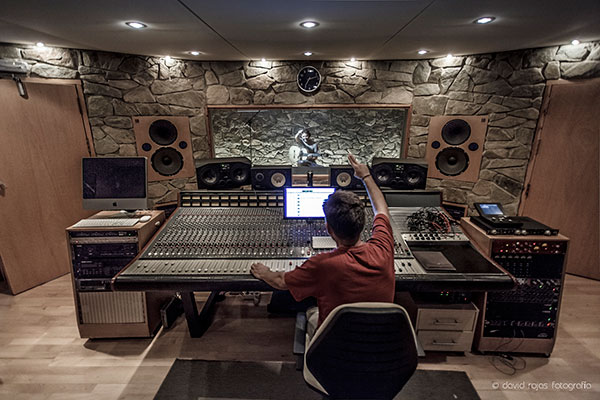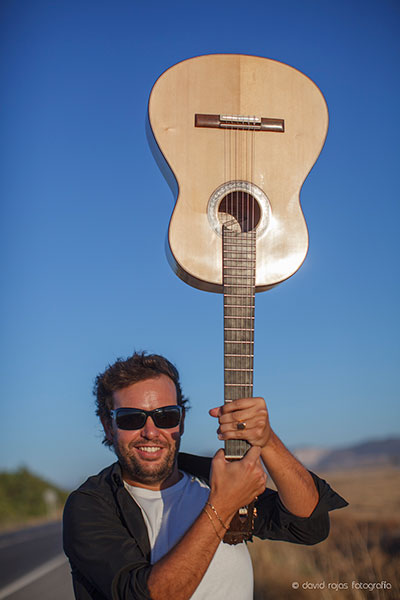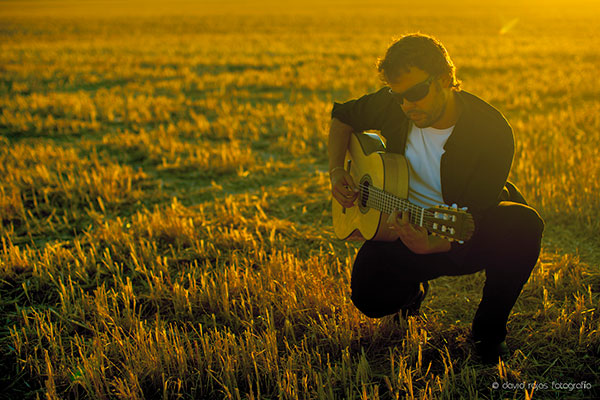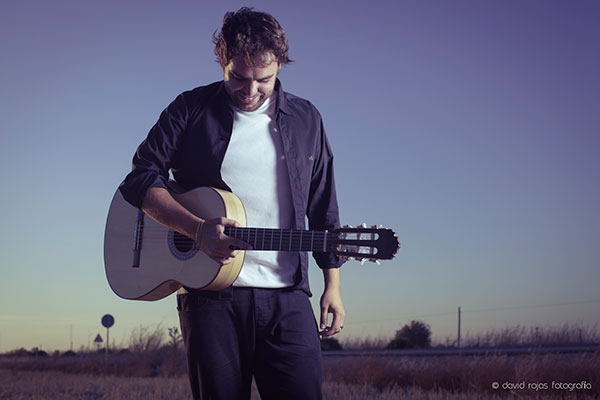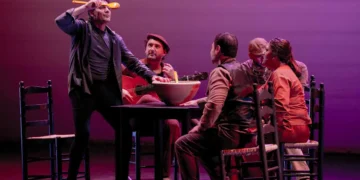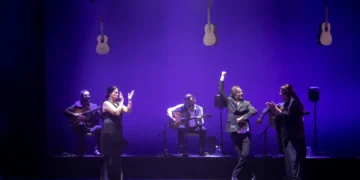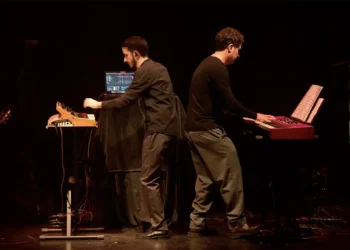Text: Manuel Moraga
Photos: David Rojas
«Something is good if it lasts a short time, if it's unique and if it's in the midst of silence»
His music sticks in your ear with just one listening. You immediately see something different that catches, even demands your attention: this is a guitarist to be reckoned with. Now we can give that attention, because the music has been recorded without interference. Dani de Morón, in unadulterated state, without vocals and with only the most basic arrangements to highlight his guitar and his ideas. It’s his first album, and already important. It’s called “Cambio de Sentido”, ‘change of direction’, and it really is a turning point in the course of today’s flamenco guitar.
I have to ask, is it Dani de Morón, or Dani Méndez?
Yeah, there’s a little confusion about that. I’m really very happy to have the name of a town that made flamenco history, where there have been and continue to be great artists, but it’s just the name that stuck. In actual fact, I’m not even Dani Méndez, my name is Daniel López Vicente, but when I worked with Antonio Canales, in order to get rid of “Dani de Morón”, which didn’t really sound good, we put some thought into it. Daniel López wasn’t right either. Canales asked me what my parents’ second surnames were, and my mother had Méndez. We thought it sounded cool, and decided on that, but in the end I went back to Dani de Morón, because that’s how most people know me.
“I definitely wanted a guitar record where the guitar would do the singing.”
The title of the record is the same as that musically and rhythmically complex bulería you call “Cambio de Sentido”, is it just a coincidence?
At first it was just the title of that builería, because there’s a part in the middle when the guitar is alone with handclapping and there are easily recognizable musical phrases that sound like Morón, but each phrase is rhythmically altered. So it seemed like a good idea to put that title, and it was interesting because the three words are related to traffic. When the record was finished, I had to think up a title, and I decided on that, for a variety of reasons, all of them positive, things you have to go through to put order, otherwise, it doesn’t take shape. So then there was a change of direction that changed the direction of my life, and the title seemed very appropriate. Then we also played with the phrase for the cover of the record, that turnaround so associated with traffic. Anyhow, it doesn’t matter that the title of the record is the same as that piece, it was just very appropriate for other reasons.
It’s a CD with twelve compositions, and many of them are considerably long, which isn’t bad for a first recording, but how much material did you leave out?
In actual fact it’s more like nine, because some of the pieces are not so much compositions as such, but rather introductions, but the track makes it an independent piece. For example, in the rondeña there’s a free-form part, and then a rhythmic part, but I figured any listener could go directly to the second part. And, well, it’s true you keep composing things, a thousand nuances recorded on the telephone, and then you start pulling ideas together. In my case, I have my studio right at home and that’s where I record and develop ideas. Maybe you develop twenty pieces, and in the end you put them together to form part of a complete work, I mean related things, to make it a cohesive work. Then I did the selection, and whatever was eliminated was put aside for possible future use, which might be a second record, or maybe part of a choreography. It’s not a question of holing up somewhere in the mountains for a month, and then emerging, “now I’ve got my record!”, but rather a slow process of selection, modification, adding and subtracting.
“The second challenge was producing my own record, I mean seeing to what point I was capable of being critical with my own work, for better or for worse”
You produced the record yourself. Being the composer and interpreter, did you have a clear idea of what you wanted, the arrangements, sound quality, etc.?
I definitely wanted a guitar record where the guitar would do the singing. The hardest thing, at least for me, is to create phrases that can be hummed, something all the greats have. For example, Paco de Lucía, although a certain work may be musically complex, there’s always a theme that can be sung. It’s a challenge, and more so for me because I’ve always had the defect of avoiding those melodies. So when I began composing and putting material together for this record, I knew I was going to strive for that, although I didn’t know if I would achieve it. And as the recording progressed, I realized it made sense, that I could go one for an hour without being boring, incorporating transitions for example, so you don’t go directly from bulería to soleá, but instead there’s a kind of breathing space the ear can appreciate. And all the while, like I say, trying to make the guitar sing.
But was the self-production something you’d planned on?
Actually, my original idea was to have Isidro Muñoz produce the record, which would have been great. I can only hope that someday we have time and resources to have that maestro devote his time to something like this. He gives everything in each record he produces. But what happened was, when we already had a rough draft, I was faced with another challenge. The first challenge was what I just described, the composing angle. The second challenge was producing my own record, I mean seeing to what point I was capable of being critical with my own work, for better or for worse, because sometimes you really like what you’ve done, and that’s dangerous, and other times you’re so dissatisfied with yourself, you end up discarding things that are really worthwhile. I had to prove to myself I could do all that, and then listen to myself after two or three months and find a certain coherence, and that the work would say what I wanted it to. In the end, I’m very happy, among other things, because putting out a record is already something, and doing it without cante, which was what I wanted, and self-produced… And my friends are being very supportive. Although it was a double challenge, I’m very pleased with how everything turned out.
“It gets attention when you do something traditional but inserted in a different way”
You have a great sense of rhythm. Or maybe it would be more accurate to say you have a peculiar sense of rhythm, and that’s one of your trademarks, because it shows not only in solos, but also accompanying singing. I remember performances and recordings of yours with Jesús Corbacho, with Antonio Campos and others, and when your guitar sounds, it’s unmistakable that it’s you.
Yes, it’s possible. And there are also people who want to do things with music that I think up, and that’s the best present any musician can have: that someone wants to play or dance something of yours. And yes, it gets attention when you do something traditional but inserted in a different way. And that’s what the “change of direction” is about. Fact is, I have a great time taking a riff, displacing it rhythmically to then close it out in a flamenco way and go after the “olé!”. It’s something I love to do, although maybe at times I go a little too far. But yes, I love that, I’m hooked on it because there are so many possibilities. For example, an insignificant phrase, if you give it a rhythmic twist it can become a work of art. And vice versa, a phrase that might be wonderful, if you do it without rhythmic interest, it doesn’t quite come off. In fact, it’s been more interesting for me to do rhythmic things than technical things. Obviously you have to always have technique to get good sound and be understood, but what I love most is the rhythm. And above everything else, the strums, because that’s the flamenco guitar’s calling card, the strums, and that’s something no one else has, I think we really need to develop a lot. Strumming sounds flamenco. I love it and study it a lot, and practice it all the time. That’s one thing about this record, twenty million different strums.
When I hear you play I have a similar feeling to what I experience with José Valencia’s singing, it always seems like you’re pulling back on the rhythm.
Well, that feeling of yours is brilliant, because that’s exactly what’s happening. When you start getting hooked on the rhythmic aspect, you value other things. And it’s not that I’m pulling back, but when you’re playing something slow, like a soleá, and you really feeling latched on to the rhythm, it’s sounds like pulling back. But it’s the importance you’re giving it. I’ve been very lucky, and I have to mention maestro Isidro Muñoz once again, because when I met him during the production of a record of Arcángel’s, it was a life-changing experience for me: he taught me to appreciate things that I don’t know if I would ever have noticed. Or maybe I would have realized forty years from now. For example, the importance a note has in time, one simple note. And that a musical phrase has to be clearly understood. If it has a specific measure, you have to do what your intention is. If you always have that in mind, everything is better understood. If you move in that kind of time which is a little hard to comprehend, and on top of it you’re going a mile a minute, not listening to yourself, nothing can be understood. That’s what I learned from Isidro. So when you say my music sounds like it’s pulling back, I take that as a compliment.
You like silences, don’t you…
I like silences. I think something is good if it lasts a short time, if it’s unique and if it’s in the midst of silence. Because if you do a good closing, but then you repeat it twenty times, it’s no longer interesting, and if no silence precedes it, that’s no good either. Silence itself, it’s been said many times, is part of music, and on a recording there aren’t only notes, there are also silences.
The personality you have on guitar, do you search for it, or does it just come naturally?
Everything takes work. Thousands and thousands of hours. The thing is, having a personality isn’t just saying you’re going to have one…something has to be there within each individual. There are times, although you don’t want to admit it, that from wanting to copy someone, and not having the necessary technique, you look for ways of getting around it and something of your own comes out. For example, it’s very hard for me to do some thumb techniques, but I’ve created alternatives that sound like me and are mine, and everyone who copies that knows it’s mine. I’m sure there are millions of things like that, all the inventions that appear. Nothing comes out of nothingness, there always has to be something first. If you think I have a personality of my own, that makes me very happy because it’s true that I do things the way I feel them. And I take advice from everyone, I learn from everyone and take things from everyone, actually copying them, but when I have to go out on stage or make a record, it gives you freedom to do what you want, never forgetting that what we’re doing is flamenco. I don’t even need to think about it, because flamenco is all I know how to do, and little by little I pick up something from something else, and when I do it, it sounds flamenco because I don’t know anything else.



